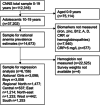Anaemia in Indians aged 10-19 years: Prevalence, burden and associated factors at national and regional levels
- PMID: 35719126
- PMCID: PMC9480897
- DOI: 10.1111/mcn.13391
Anaemia in Indians aged 10-19 years: Prevalence, burden and associated factors at national and regional levels
Abstract
Anaemia control programmes in India are hampered by a lack of representative evidence on anaemia prevalence, burden and associated factors for adolescents. The aim of this study was to: (1) describe the national and subnational prevalence, severity and burden of anaemia among Indian adolescents; (2) examine factors associated with anaemia at national and regional levels. Data (n = 14,673 individuals aged 10-19 years) were from India's Comprehensive National Nutrition Survey (CNNS, 2016-2018). CNNS used a multistage, stratified, probability proportion to size cluster sampling design. Prevalence was estimated using globally comparable age- and sex-specific cutoffs, using survey weights for biomarker sample collection. Burden analysis used prevalence estimates and projected population from 2011 Census data. Multivariable logistic regression models were used to analyse factors (diet, micronutrient deficiencies, haemoglobinopathies, sociodemographic factors, environment) associated with anaemia. Anaemia was present in 40% of girls and 18% of boys, equivalent to 72 million adolescents in 2018, and varied by region (girls 29%-46%; boys 11%-28%) and state (girls 7%-62%; boys 4%-32%). Iron deficiency (ferritin < 15 μg/L) was the strongest predictor of anaemia (odds ratio [OR]: 4.68, 95% confidence interval [CI]: [3.21,6.83]), followed by haemoglobinopathies (HbA2 > 3.5% or any HbS) (OR: 2.81, 95% CI: [1.66,4.74]), vitamin A deficiency (serum retinol <20 ng/ml) (OR: 1.86, 95% CI: [1.23,2.80]) and zinc deficiency (serum zinc < 70 μg/L) (OR: 1.32, 95% CI: [1.02,1.72]). Regional models show heterogeneity in the strength of association between factors and anaemia by region. Adolescent anaemia control programmes in India should continue to address iron deficiency, strengthen strategies to identify haemoglobinopathies and other micronutrient deficiencies, and further explore geographic variation in associated factors.
Keywords: India; adolescent; anaemia; micronutrients; public health.
© 2022 The Authors. Maternal & Child Nutrition published by John Wiley & Sons Ltd.
Conflict of interest statement
The authors declare no conflict of interest.
Figures




References
-
- Abraham, R. A. , Agrawal, P. K. , Johnston, R. , Ramesh, S. , Porwal, A. , Sarna, A. , Acharya, R. , Khan, N. , Sachdev, H. S. , Kapil, U. , Saxena, R. , Janmohamed, A. , Wagt, A. , Deb, S. , Khera, A. , & Ramakrishnan, L. (2020). Comparison of hemoglobin concentrations measured by HemoCue and a hematology analyzer in Indian children and adolescents 1–19 years of age. International Journal of Laboratory Hematology, 42, e155–e159. - PubMed
-
- Ahankari, A. S. , Myles, P. R. , Fogarty, A. W. , Dixit, J. V. , & Tata, L. J. (2017). Prevalence of iron‐deficiency anaemia and risk factors in 1010 adolescent girls from rural Maharashtra, India: A cross‐sectional survey. Public Health, 142, 159–166. - PubMed
-
- Ahmed, F. , Khan, M. R. , Islam, M. , Kabir, I. , & Fuchs, G. J. (2000). Anaemia and iron deficiency among adolescent schoolgirls in peri‐urban Bangladesh. European Journal of Clinical Nutrition, 54, 678–83. - PubMed
-
- Allison, P. D. (2003). Missing data techniques for structural equation modeling. Journal of Abnormal Psychology, 112, 545–557. - PubMed
MeSH terms
Substances
LinkOut - more resources
Full Text Sources
Medical

